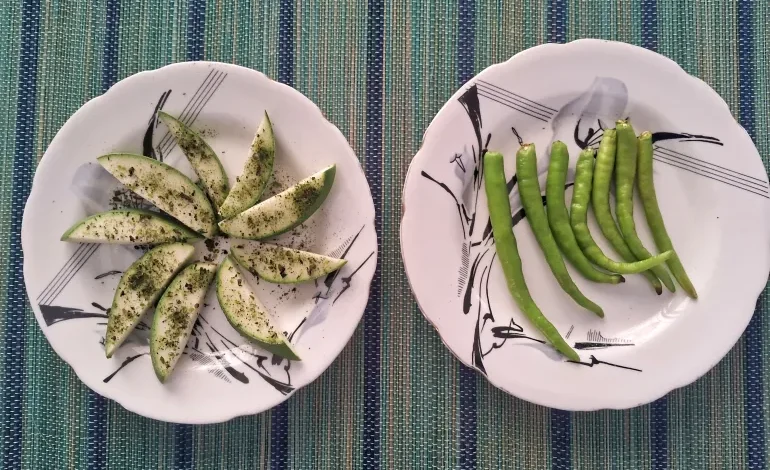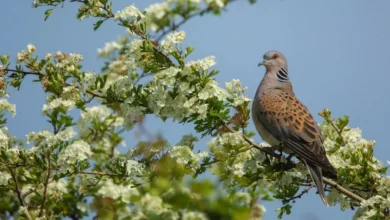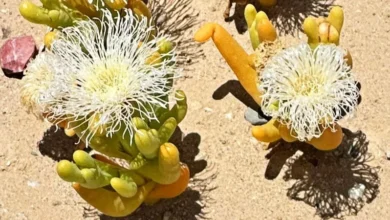The legendary flavoured ground salt from India: Pisyu loon

On the plate in front of me, raw mango slices have been carefully arranged into the petals of a flower. My friend, Alka Dogra, urges me to eat them right away.
One bite, and immediately, my tastebuds are alight with hot, piquant salt that pairs beautifully with the sourness of the fruit.
“This has the hari mirch pisyun loon (green chilli salt) from Uttarakhand you so wanted to taste,” she shares.
But I hardly listen, already transported back in time. It’s lunchtime in sixth grade and we’re eating our way through our lunches. A girl named Mahima brings out a small packet and asks, teasingly: “Kis kis ko chahiye (How many of you want)?” We jump with delight: This is her mother’s irresistible signature spice mix.
We spread out guavas, apples and oranges. I sprinkle the coarse, deep green mixture on an orange slice and pop it in my mouth. The sharp salt and hot chilli mix with the sweet and sour orange juice in a fiery, tangy explosion of flavour.
We craved that legendary spice mix. And when Mahima left school the next year, we had to eat our fruit with plain salt, sulking.
I’d almost forgotten this memory, but 20 years later, I was reminded while enjoying some fruit with Alka in Delhi one sunny winter afternoon. She lamented: “Daadi ka pisyun loon hota to kya baat thi (If only my grandmother’s flavoured salts were here).”
“Pisyun what?” I asked, confused.
“It’s our special salt from Uttarakhand,” she responded and promised to share some pisyun loon with me the next time her mother sent some.
It was worth the wait. As I savour the salt-sprinkled mango slices Alka has laid out for me, I am delighted to now have a name for the spice mix I loved so much as a schoolgirl.
A cherished condiment
Pisyun loon (which translates to “coarse salt ground with spices”) is a cherished condiment in Uttarakhand. Deeply connected to the local culture, there are even songs written about it. “Hoon Pissyu lone” tells the story of a boy’s longing to return to his village for his mother’s salt. And “Hai Kakdi Zilema loon pisse sile ma“ is about a girl who sees ripe cucumbers and dreams of happily grinding salt for her fiance.
Culinary expert Rushina Munshaw Ghildiyal says she discovered that the salty condiment exists only in the kitchens of Uttarakhand. In her documentation of the area’s cuisine, which she has been compiling for 25 years in efforts to capture recipes – her husband is originally from the area – she has recorded more than 17 types of flavoured salts, each with claims to “health and medicinal properties.”
“Every cook and home in this region has their own variations based on individual and family tastes,” she says, adding that she is looking to publish a cookbook next year.
Home chef Nitika Kuthiala, who is an expert in cuisine from Himachal, a neighbouring state, says: “It is like the Indian quintessential garam masala [everyday spice mixture] recipe every family has and is prepared with whatever is available.”
People who have grown up with the condiment often have fond memories from their childhood. Nandini Jayal Khanduri, who is a jewellery designer from the state capital Dehradun, remembers running home from school every day to watch her mother making khatai with neighbours while sitting in the winter sun.
The mixture, which is a regional favourite, is prepared with chakotra (grapefruit), malta (blood orange) and galgal (hill lemon). The fruit is peeled and pulped before mixing with the salt and spices. Sometimes roasted sesame powder is added to reduce sourness. It’s often enjoyed with parathas or flatbread. “My mouth waters even as I speak about the khatai,” Khanduri says, laughing.
Salty history
Because salt is an essential element for vital body function, and humans also tend to crave it, it’s historically been used as currency, but also heavily taxed and even at the centre of conflicts, such as the War of Ferrara (1482–1484) between Venice and Ferrara and the Salt War (1556–1557) between Naples and the Papal States. The famous Dandi March, also known as the Salt March, led by Mahatma Gandhi in 1930 was a vital event during India’s struggle for independence from British rule. It was a non-violent protest against the British-imposed salt tax, which gave the British government a monopoly on salt production and distribution, making it illegal for Indians to collect or sell salt.
Salt’s indispensability and cost made it precious, forcing people to find more of it — Ghildiyal cites a wild salty leaf used by the tribal communities of the Sahyadri region in western India and a saltbush used by the Aboriginal community in Australia – and use it sparingly.
Because of its potency, salt can be used in small amounts to make pickles, chutneys and loons (salts), allowing it “to be stretched”, Ghildiyal adds.
That’s why “this salt tradition developed in both Svaneti, Georgia, and Uttarakhand, India, two mountainous places where salt had to be carried over difficult terrain”, explains Naomi Duguid, a Canadian cookbook author who wrote The Joy of Salt. In Quebec, Canada, a salt mix called “herbes salees” is made with finely chopped fresh green herbs and chopped carrots, then stored in jars and used as a seasoning for a variety of dishes, Duguid explains.
The origins of pisyun loon remain somewhat of a mystery. However, Ghildiyal has a theory: The Bhutiya community, which spans the three Indian states bordering Tibet and Nepal (Sikkim, West Bengal and Uttarakhand) historically traded herbs and spices with each other. Because salt was sold in rocks or blocks, it needed to be ground with a silbatta (grinding stone) – spices also required grinding. Ghildiyal believes that this led to the accidental creation of flavoured salt. “Someone would have used the mortar and pestle that was used to grind something else previously to crush the salt and found the residual masala left on the stone augmented its flavour.”
Crafting flavoured salts
There is no documentation of recipes, variations or combinations of these salts, shares Ghildiyal. Family recipes, which are “mostly handed down by great grandmothers and grandmothers”, have been rooted in the availability of ingredients, personal preferences and “the home’s main cook’s philosophy” – even the medicinal properties of the ingredients. Thus, mixtures differ from home to home and from region to region.
This is also the case with svanuri marili or Svan salt, the flavoured salt of Svaneti, Duguid notes, which typically includes dill, fenugreek, marigold petals, coriander, caraway, dried red chiles and a lot of garlic. It can be used as a meat marinade or rub, seasoning during cooking or a condiment.
For pisyun loon, dried spices such as asafoetida (fennel), basil, carom (caraway), mint, coriander or green chillies are added to white, pink and sendha namak (rock salt), Kuthiala says. Fresh coriander, which is not always available in this region, is used when in season. “The main ingredient is salt, and you can add anything you prefer.”
In the Kumaon region, salts made from bhang (hemp seeds), jakhya (wild mustard) and bhang jeera are quite popular, Joshi says.
In Uttarakhand, green garlic salt is a winter speciality. Also during this season, iodine, pink and rock salts are blended with amchur (dry mango powder) and sprinkled on oranges, guava and papaya. In the summer, mint salt and chilli cumin salt are very popular, and various salts are added to dahi raita (yoghourt mixed with tomatoes, onion or cucumber) and mattha (tempered buttermilk).










